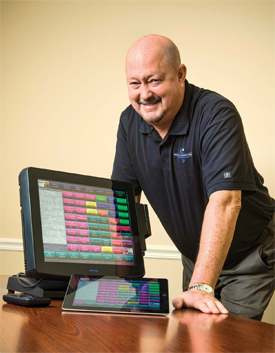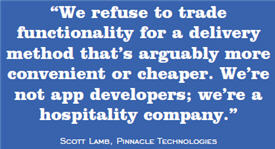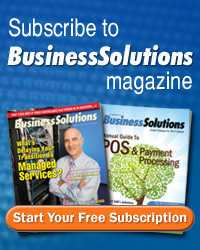POS Is Not An 'App'

By Matt Pillar, chief editor
While mobile POS fuels its double-digit growth, this VAR is quick to discount the cloud-based, “POS lite” apps flooding the market.

Scott Lamb doesn’t mince words when he acknowledges that the mobile POS craze is changing the channel. “Plenty of resellers are going out of business at the hands of mobile POS,” he admits. But Lamb’s reflections on the transformative nature of mobile POS aren’t tinged with the cynical negativity that plagues so many old-guard dealers. His company, Orem, Utah-based Pinnacle Technologies, has embraced the hospitality industry’s appetite for mobile POS. In fact, he says it’s driving revenue growth there despite the fact that Pinnacle makes little or no profit margin on the very mobile devices that run the company’s Digital Dining software. Here, Lamb offers five strategies for thriving in an increasingly mobile environment, strategies he and partners Nate Evans and Jay Hoover have honed over six years of learning and growth at Pinnacle Technologies.
Get Your Head Out Of The Cloud
While many POS system dealers have jumped on the cloud bandwagon as a means of software delivery, Lamb won’t risk application performance degradation at the hands of perceived convenience. “Digital Dining is a full-featured software suite, and when used to its full potential, it’s bandwidth-intensive,” he says. “While many of our competitors have moved their lighter applications to the cloud, a powerful business application consumes too much bandwidth to run over the Internet for more than a couple of terminals,” he says. That’s not to say Lamb discounts cloud delivery altogether. Reporting, for instance, is a perfectly acceptable way to leverage the anywhere, anytime convenience of cloud data delivery. But for Pinnacle’s core POS applications, the company recommends a local database. “Many of the newer POS products, especially those built for mobile devices, are really just apps. They might run fine via the Internet on a couple of terminals. But a deep application that’s been perfected over 30 years needs an optimally stabilized delivery platform to do its job,” he says.
This point of view is not alien to Pinnacle’s customers, despite the craze for the cloud. Lamb says his customers are skeptical of it, and that skepticism is a product of their assessment of real-world cloud-based applications they’ve seen, or worse, experimented with to lackluster results. “We refuse to trade functionality for a delivery method that’s arguably more convenient or cheaper. We’re not app developers; we’re a hospitality company,” says Lamb.
Don’t Sweat The Small Margins
As the demand for mobile POS solutions grew in the restaurant and bar industries, Pinnacle quickly realized that it had to embrace iOS, Android, and Windows mobile devices. Fortunately, its flagship Digital Dining software suite was among the first to develop for them. “Most customers still include at least one traditional fixed POS station in their establishments, but the market is moving toward hybrid fixed/mobile environments. Several customers are going totally mobile, whereby all the guest sees are mobile POS devices,” he says. “When we began deploying these devices in our local database environment, we saw firsthand that the infrastructure is solid. The network is stable, the customer doesn’t have to give up any functionality, and the devices don’t fail.”
Still, he admits the erosion of hardware profit margin was concerning. “You have to get your head around the fact that it’s a waste of time to try making $20 on an iPad,” says Lamb.
Instead, Pinnacle encourages its customers to source mobile devices themselves. If the customer wishes, Pinnacle will do the sourcing, but without any markup.
Pinnacle does make a profit on the rest of the physical POS infrastructure — the stuff that requires some level of expertise to procure and engineer — such as servers, mobile printers and credit card readers, bar code readers, iPad stands, and even wireless access points. “We learned from experience that our customers are willing to pay for infrastructure and integration expertise; too many attempted it themselves only to realize that not all these components play nice with one another,” says Lamb. “On hardware, that’s how we start making money.” Lamb says the quality of the peripherals he sells demands respectable margins, and his market accepts that reality. “Take our Linea Pro credit card readers, for example. We get requests for Square because it’s cheap, but Square Readers are built to support light-duty apps, not our software. We’ve seen them break off when they get caught in wait staff’s aprons. It’s not difficult to communicate the perils of downtime, so we make a healthy profit margin on purpose-built peripherals from companies such as Linea Pro and Epson.” In fact, Lamb is quick to point out that even Apple stores use Linea Pro — not Square — for mobile card acceptance.
With that said, the philosophy that there’s more money to be made on knowledge and expertise than on hardware is central to Pinnacle’s approach. But POS expertise is just one part of the equation. Lamb says the changing margin landscape makes it equally important to run an efficient business. “We go to great lengths to find the best deals on the products we sell. We work extensively with our vendors and do our homework to find the best deals. Even simple things like taking advantage of free shipping can improve your profits,” he says.
While he advises against depending on them as a core source of revenue, Lamb says residual revenue opportunities are a smart source of profit security as well. “When I started in this business, we sold cash registers and DOS computers. There were no residuals. But, the industry has changed, and we have to change with it.” Today, Pinnacle earns monthly recurring revenue from its own subscriptionbased, tiered service and maintenance plan. It also enjoys recurring revenue arrangements with its Vantiv card processing platform and frequent diner/loyalty programs (See sidebar on this page).
Sell Security
Pinnacle has been selling integrated security solutions — an imperative in the hospitality industry — since its inception. He says PCI concerns and sweethearting drive the demand for his company’s security offerings. “Some experts estimate that up to 80 percent of identity theft originates in the hospitality industry. Patrons have been trained to allow servers to take their credit cards out of sight, opening the door for credit card fraud,” he says. The combination of tableside payment acceptance enabled by mobility, attentive compliance with PCI mandates on the part of Digital Dining, and the attention Pinnacle pays to securing the network infrastructure remove the opportunity for the lion’s share of this fraud. “The more aware of card and network security issues our customers are, the more money we make on the sale of PCI-compliant solutions,” says Lamb.
Equally important to hospitality security is the integration of surveillance and POS, which Pinnacle accomplishes with Talon digital video recorders. “Our Talon integration gives our customers a text overlay of the POS, which they can access remotely on their mobile devices,” he says. “This is especially popular in bar and nightclub environments, where managers and owners can watch for sweethearting from anywhere they have an Internet connection.”
 As with its POS peripherals, Pinnacle must convince its customers that premium security hardware — and integration — are worth the premium price they demand. “Our customers are aware that they can get a security system for $500 at Costco. But Costco doesn’t use the commodity surveillance equipment it sells. Do-it-yourselfers don’t get commercial hardware, and they typically can’t handle POS integration and mobile access,” he says. “If a business owner is willing to sacrifice quality and functionality for price, they’re probably not a good fit for Pinnacle.”
As with its POS peripherals, Pinnacle must convince its customers that premium security hardware — and integration — are worth the premium price they demand. “Our customers are aware that they can get a security system for $500 at Costco. But Costco doesn’t use the commodity surveillance equipment it sells. Do-it-yourselfers don’t get commercial hardware, and they typically can’t handle POS integration and mobile access,” he says. “If a business owner is willing to sacrifice quality and functionality for price, they’re probably not a good fit for Pinnacle.”
Sell More
While it may be easier said than done for a small VAR, Lamb says simply selling more has been key to its growth. “For a lean organization to take on more volume, it has to carefully examine where business practice change can be made without sacrificing its quality of service.” To provide one profoundly simple example, Pinnacle has scaled back the number of technicians it sends on-site to deploy its technology. “Historically, we would send at least two technicians at a time to complete an installation. When we were selling PC-based registers, peripherals, kitchen video and surveillance systems, that was necessary. There was a lot of heavy lifting, cabling, and configuration involved,” he explains. For many VARs, that mentality persists. But Lamb says the prevailing swing toward mobile devices and wireless networks allows him to send one technician on most installation engagements, freeing up labor to take on more work. “We give the customer our complete attention, but we don’t linger. We get things up and running, and we get on to the next project.”
The company has also benefitted from the efficiency boon made possible by remote support. “We can sell software upgrades and implement them remotely, which dramatically reduces our overhead. We have customers as far away as Honolulu that we support remotely,” says Lamb.
 Sell Your Experience
Sell Your Experience
Key to monetizing mobile sales is selling the value of your experience. To many small and independent hospitality operators, the appeal of mobile devices is limited to tableside POS. Lamb says his company sells more holistic solutions by demonstrating the additional functionality afforded by mobile devices. “We show our customers how they can improve operations using all the facets of our solutions on mobile devices, which compels them to buy more of those solutions,” he says. Mobile video, discounting, comps, reporting, and table management are a few examples of the tasks managers and wait staff can accomplish from anywhere using mobile devices.
Lamb stresses that a lab- or office-based demo may not be enough to convey the value that drives the sale. He points out the difference between demonstration and consultation; conferring expertise is where real sales value lies. “We’re not shy about sharing our knowledge of the operational and HR change that’s necessary when mobility is deployed,” he says. “For example, one advantage of mobile POS for restaurants is labor efficiency. But to realize that advantage, the staffer holding the device must stay tableside. They need to train. They need to be confident enough to work the floor, engaging people all the time,” he says. As such, Pinnacle demonstrates how, in the hands of a confident server, mobile engagement drives upsells. Four-finger gesturing, for instance, allows servers to toggle between the POS application and images of appetizers and desserts. “The server must have the training and confidence to do this, and it’s up to the operator to ensure that,” says Lamb. “In the wrong hands, mobile POS won’t net anything.”
Pinnacle sells more mobile solutions by educating its customers on the intricate behind-the-scenes benefits of mobility as well. The customer experience is improved when a server doesn’t need to move from table to terminal to place orders and take payment, but so is the establishment’s workflow. “When orders are placed remotely as the server moves from table to table, the kitchen workflow improves significantly. Orders can be prepared in perfect sequence, as they’re placed,” says Lamb. He also notes that educated servers are often the strongest supporters of the mobile devices Pinnacle sells. “In fact, they’ll fight over them. It’s proven that being armed with mobile tools like these yields more tips due to better service.”
While straight-up operational consulting services aren’t on Pinnacle’s line card as of yet, Lamb says the valueadded consultation it offers helps the company sell more at a better margin. “We’re experts in the field, and sharing that expertise is key to our sales strategy.”

